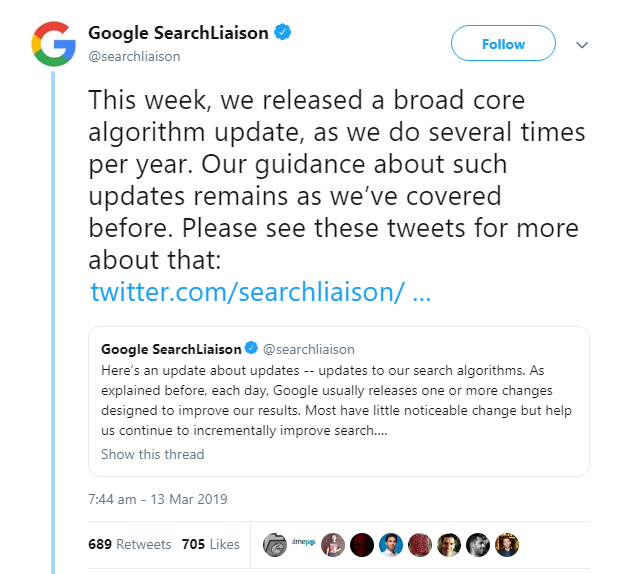The last few months have been relatively quiet in the SERPs, but now the time has arrived and Google is introducing a major core algorithm update. In this post you’ll find out what this “March 2019 Core Update” is all about.
It was late yesterday evening when we got the first messages out to customers. The rumours we’d seen during the day had been confirmed by Google.
The effects of the update, known as the “March 2019 Core Update” can be seen well in the SISTRIX Toolbox data so in this report we’ll give you the current knowledge about the update, and show you example UK winners and losers that have been affected. Through the Toolbox you’ll be able to do further research and comparisons with your own domain.
What is a Core Algorithm Update?
Under the very general term “Core Algorithm Update” Google rolls-up general updates into the ranking algorithm that may have a large impact on many domains. Unlike in the past, it is often unclear what Google’s direct goals are with these updates.
Presumably, this is because Google relies less on classical, human-input ranking algorithms now in favour of self-learning, machine-built algorithms. More background thoughts can be found in this article that covers user experience and ranking factors.
How do I spot domains affected by this update?
Domains affected by this update have a very characteristic increase / decrease shape in the daily visibility history from the 14.03 (14th March) in the to the 15.03. (today). You can see that very clearly, for example, at last.fm. In the UK we aren’t seeing changes as strong as we’re seeing in Germany where some losses are well over 50%. However, that 14th March ‘tick’ is visible in all cases.

Likewise, the winners from this update show an uptick from the 14th to the 15th of March. In the days leading up to the 14th there are no obvious signs of major change.
Algorithm Update Winners
With a core update. it’s not only possible that domains will lose visibility. There are winners too and in the list below you find a selection of domains that have gained through this update. [Raw data. Varies slightly from daily data visible in the Toolbox.]
What’s interesting here is that many of the affected domains (75% of this sample) were also affected by the big updates of 2018. (Core Update March 2018 and the Medic Update in August 2018.)
| draxe.com | 4.23 | 6.33 | 2.10 | 49.69% |
| raccars.co.uk | 7.08 | 9.39 | 2.31 | 32.57% |
| medicinenet.com | 22.93 | 30.28 | 7.35 | 32.06% |
| newsnow.co.uk | 17.10 | 22.36 | 5.26 | 30.75% |
| buzzfeed.com | 14.60 | 18.93 | 4.33 | 29.65% |
| engadget.com | 9.00 | 11.35 | 2.35 | 26.16% |
| schuh.co.uk | 8.76 | 10.91 | 2.16 | 24.62% |
| silvergames.com | 5.37 | 6.62 | 1.25 | 23.27% |
| bmstores.co.uk | 9.67 | 11.77 | 2.10 | 21.68% |
| helpguide.org | 6.75 | 8.15 | 1.39 | 20.60% |
| rateyourmusic.com | 19.17 | 23.10 | 3.92 | 20.47% |
| medicalnewstoday.com | 71.50 | 85.69 | 14.19 | 19.85% |
| expertreviews.co.uk | 15.56 | 18.40 | 2.84 | 18.26% |
| metro.co.uk | 18.62 | 21.89 | 3.27 | 17.57% |
| digitalspy.com | 24.10 | 28.21 | 4.11 | 17.08% |
| t3.com | 9.75 | 11.19 | 1.43 | 14.69% |
| techcrunch.com | 10.77 | 12.19 | 1.42 | 13.23% |
| thekennelclub.org.uk | 14.38 | 16.25 | 1.87 | 12.98% |
| rspca.org.uk | 11.03 | 12.45 | 1.41 | 12.82% |
| brainyquote.com | 14.49 | 16.34 | 1.85 | 12.75% |
Algorithm Update Losers
Across the list of losers it’s noticeable that there are a few domains that fall into the “Your money, your life” category but there are others too. The top losers in our data aren’t as strongly hit (in terms of percentage) as the winners.
| complex.com | 13.30 | 9.98 | -3.31 | -24.93% |
| everydayhealth.com | 47.61 | 36.89 | -10.73 | -22.53% |
| goal.com | 10.48 | 8.41 | -2.07 | -19.72% |
| health24.com | 15.33 | 12.79 | -2.54 | -16.56% |
| hsamuel.co.uk | 32.29 | 27.79 | -4.50 | -13.94% |
| businessinsider.com | 29.34 | 25.73 | -3.61 | -12.31% |
| ernestjones.co.uk | 18.76 | 16.56 | -2.20 | -11.71% |
| netdoctor.co.uk | 22.41 | 19.86 | -2.55 | -11.37% |
| variety.com | 24.53 | 21.84 | -2.68 | -10.94% |
| last.fm | 50.16 | 44.76 | -5.40 | -10.76% |
Again, among the losers there are many domains (70%) that were affected by previous core updates. It appears that Google is, once again, working on the same parameters. Evaluation criteria and underlying data could be the same.
Update 26.03.2019
With large Google updates it’s usually the case that the full effects are seen quickly; often with 24 hours. Sometimes it takes a few days and in most cases we’re seeing most domains fit that pattern. However, there are some domains affected by this updates that are continuing to react.

The loss here during the first week was a huge 80% from a start of 47 VI points but changes in the second week are already at 20%.
The evaluation of the domain here was not completed in the first week but is being updated in multiple passes. There’s much to suggest that its due to crawling data that first has to be evaluated before the page ranking is adjusted.
Summary
Once again, Google has released a major and far-reaching Core Algorithm Update and the effects are clearly visible through the SERPs and the data available for many domains in the Toolbox.
Since this is already the fifth (or sixth, depending on how you count the updates) in the series, one can assume that there will be further updates that will follow in this form.
Hectic corrective work on a domain will not be a solution to the ranking problems caused by the update so, from today’s perspective, the following procedures are recommended:
- Read and Understand the Google Quality Rater Guidelines – Google clearly sets out its own view on search and content in the Guidelines (PDF Download). Being able to understand their point of view helps to create future-proof results for searchers.
- Keep focusing on the search intent of your visitors. What exactly does the user want from me? You will have to answer this question for every page that is created to rank well with Google.
- There are no blanket-rules for content created / revised based on these procedures. Content needs to be individualised to the keyword-cluster that you want to achieve and you need to consider the user expectations in the micro-niche.
Original post – Johannes Beus. Data updated for UK.

